
Hello, Mlindawrites family! Spring is just around the corner, and I’m excited! I was browsing Pinterest to discover how to create unique homemade Easter Sensory bins for this Spring with my son, Anthony.
I’m heavily into the parenting niche and love researching fun ways to spend the upcoming holidays with my son.
I’m marking the days off my calendar because I love doing spring activities! Anthony and I were born in April, making this season special.
In addition to our holiday festivities, Anthony and I enjoy crafting and making sensory bins together. We also read the Bible together and discuss God’s word to remind him why we celebrate Easter.
Anthony was born with cystic fibrosis and ADHD, which makes life a lot harder than other kids. He finds refuge in art therapy, which has led me to find various ways, along with help from his grandmas.
However, Anthony enjoys using sensory bins because they help him explore and regulate his mood.
Therefore, Easter sensory bins are a great option if you’re searching to keep your little ones engaged and entertained this Spring!
Anthony’s First Sensory Bin: The Spooky Bin
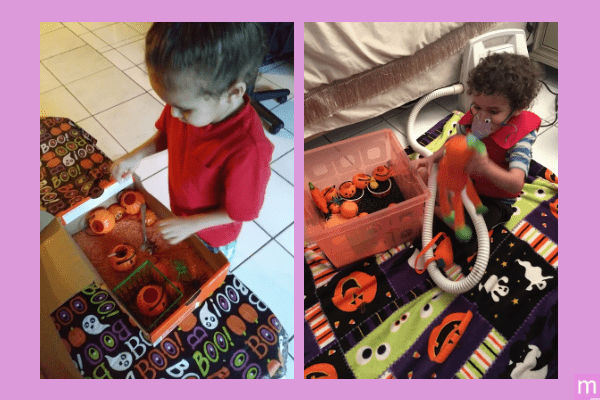
I became aware of sensory bins when my son Anthony was around three years old. I found them fascinating and created a Halloween sensory bin using orange-dyed rice.
Considering his upbringing with sensory bins, Anthony grew to love them so much that, at age nine, he still uses them. He makes great games with them and truly enjoys the beans and different textures.
I added the black beans when Anthony was three. In 2018, I changed bin sizes as Anthony got older.
This year, we decided to transform it into an Easter Sensory bin. We went all out this year, seriously!
Moreover, sensory bins are an excellent tool for children with anxiety, as they help them feel more comfortable experimenting with different textures.
These bins are also fantastic ways to stimulate the senses, encourage exploration, and provide hours of fun for children of all ages.
How does playing with a sensory bin connect with therapy?
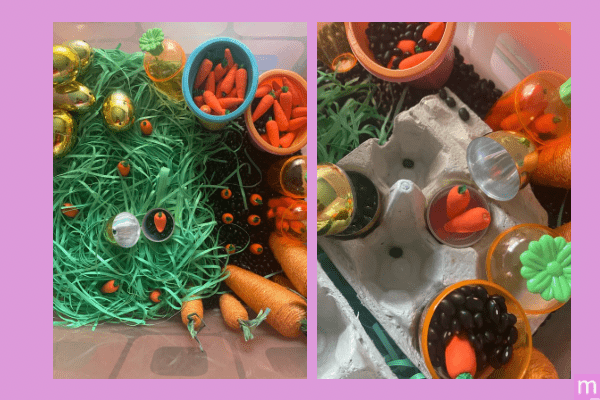
Sensory therapy incorporates activities and techniques that engage the senses—sight, smell, touch, taste, hearing, and vestibular—a sense of balance—to help people achieve specific goals.
Here are the five top benefits of sensory therapy:
- Improved Emotional Regulation: Many sensory therapy techniques profoundly impact the emotional state, providing calming and organizing input and helping individuals manage anxiety, stress, and frustration.
- Enhanced Focus and Attention: My son Anthony has ADHD and Cystic Fibrosis. Sensory therapy has dramatically helped his focus and attention span around the house.
- Increased Sensory Processing Skills: Sensory therapy can help individuals with sensory processing difficulties by exposing them to controlled sensory experiences and teaching them how to integrate this information more effectively. Motor skills, coordination, and spatial awareness all increase with sensory play.
- Boosted Communication Skills: In fact, activities that include playing with textured objects or exploring different sounds can encourage verbal and nonverbal communication as children describe their experiences.
- Reduced Sensory Sensitivities: Sensory therapy can help them become more comfortable with these stimuli through gradual exposure and desensitization techniques, improving their daily life and reducing anxiety associated with sensory overload.
Overall, sensory therapy offers many benefits for individuals of all ages. Targeting specific sensory needs can promote emotional regulation, improve focus, enhance communication skills, and reduce sensory sensitivities.
This page contains affiliate links, and I earn a commission if you purchase through one of the links at no cost to you. As an Amazon Associate, I earn from qualifying purchases.
Moving forward to the bins! This Easter, ditch the screens and dive into creative sensory play with these egg-cellent ideas! Check out these homemade easter sensory bins to spark your creativity.
1. Nest Hunt Sensory Bin
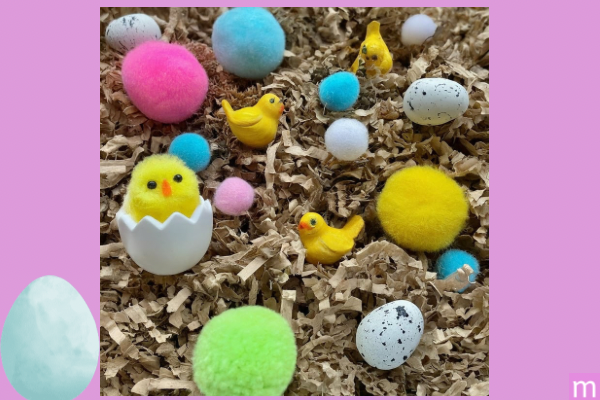
This delightful sensory bin creates a cozy nest for little hands to explore. Studying nature together can be fun, and children’s imaginations are expansive!
Here’s what you’ll need:
- Base: Shredded brown or crinkly colorful craft paper to create beautiful nesting material. Experiment a little more and try using dried garbanzo beans as a base.
- Eggs: Fill the bin with small, realistic-looking bird eggs. For a textural twist, add bumpy, fuzzy, or glittery eggs!
- Nest Fillings: Add fluffy pipe cleaners, colorful pom poms, and small wooden birds to create a realistic nest ambiance. Enlighten your child with an unexpected treat. Sneak in some plastic chicks or bunnies for an extra surprise!
Benefits: This sensory bin encourages pretend play, exploration of textures, and fine motor skill development as children scoop, sift, and search for hidden treasures. It can also help children learn to play together and distribute teamwork.
You can tap the icons above and below this page to contact me through Facebook, Twitter, LinkedIn, or Pinterest. If you need writing services, you can also use this form here.
2. Peep Chick Playdough Party DIY Easter Sensory Bin
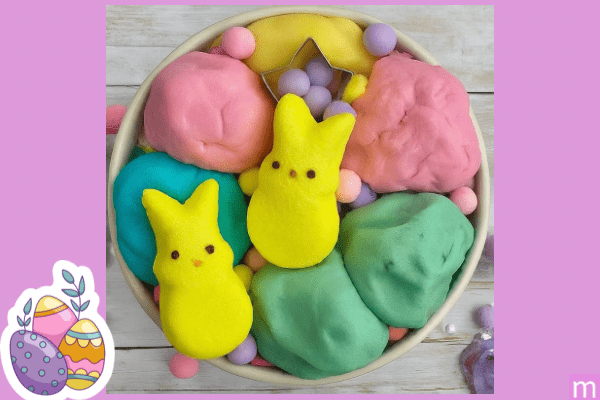
Who can resist those adorable marshmallow chicks?
Your children will adore peeps being a part of their playtime. Transform them into a delightful sensory experience with this playful bin!
- Base: Homemade playdough is always a win! However, if you don’t have any, that’s okay. I purchased this playdough from my local crafting store. Use a pastel color scheme of pink, yellow, and lavender to create an Easter egg vibe.
- Peep Chicks: Stock the bin with an army of Peep chicks in various colors and sizes. I found a great assortment here, but you can also find something similar at your local crafting store.
- Chick Mold (Optional): Include a chick-shaped cookie cutter or mold for fun.
Benefits: Playdough is also a fantastic tool for strengthening hand and finger muscles, promoting creativity, and encouraging imaginative play.
3. Homemade easter sensory bin: The Great Carrot Patch
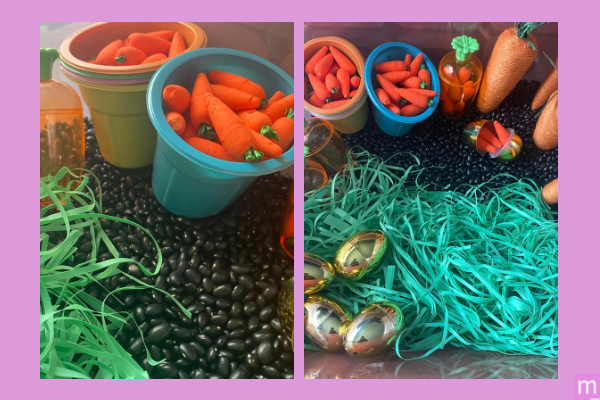
Does your little one have a green thumb and is curious about nature? How cute is this sensory bin?! Very! I learned about it from this fantastic Pinterest pin by Worpress.com and enjoyed creating it with my son.
I added many cute little carrots, making it feel like a farm. I’m obsessed with carrots, so I decided to get different sizes. This homemade easter sensory bin sensory bin is a dirt-free way to explore the joys of a carrot patch.
- Base: Black beans and crinkly grass make the base appear like a mini garden.
- Carrots: Fill the bin with plastic carrots of all shapes and sizes. Consider including some with leaves attached for added realism.
- Golden eggs: Fill some golden eggs with little prizes, such as stickers or Dollar Tree items, for your child to dig up.
- Plastic gardening tubs and tools: These tubs will help your little botanist keep their hands clean while they enjoy scooping, digging, and planting their carrots. I fell in love with this gardening set!
- See-through carrots: Using see-through carrots makes it fun for kids because they can see through the carrot. I like to fill them with black beans and hide a few mini carrots inside, which my son loves.
- Add craft bunnies for the carrots: Create your little bunnies from pom poms and googly eyes. A tiny white cotton tail is easily applied using nail cleansing cotton. (I am making some this weekend with Anthony)
Benefits: This bin is a great way to encourage imaginative play, sorting by size and color and exploring textures. It is one of my favorite bins to use all year round. The crinkly grass and black beans add an interesting auditory element as well.
4. Hatching Rainbow Rice Sensory Bin
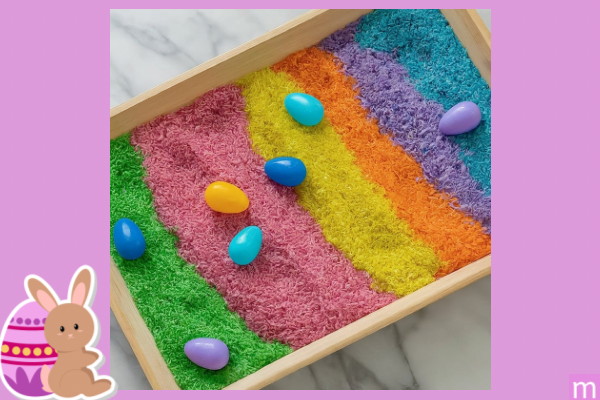
Do you have your food coloring on hand? Get ready for this craft—it’s going to be fun!
Create a mesmerizing and colorful Easter experience with this vibrant homemade easter sensory bin!
Rice is used in many different crafts. I like to use it to make rainbow crafts, like this awesome tutorial by From ABC’S to SAT’s, which I found on Pinterest.
- Base: Rainbow rice is straightforward to make! I found sorting colors easier by separating uncooked white rice into portions.
Tips:
- Each is colored with a few drops of food coloring. The colored rice is then spread on a baking sheet and let dry completely.
- I waited 4 hours to be sure, but the amount of rice varies. Once dry, you can combine all the colors in a large bin.
- Easter Basket: Include a small plastic Easter basket or cup for children to scoop and collect the rice. I used egg-dying cups from the Dollar Tree as mini gardening baskets.
- You can also use a clear cereal scooper or measuring cup LINK for your child.
- Plastic Eggs (Optional): Hide some plastic Easter eggs filled with small toys or candy for an extra surprise! It is fun to see your child’s surprise when they realize the egg they now hold is special.
Benefits: Rainbow rice is visually stunning and captures children’s attention. It keeps kids entertained for hours and helps them develop their sensory skills.
Scooping and pouring strengthen hand and finger muscles, while the colorful rice encourages sorting and exploration.
5. Sprout Garden Easter Bin:
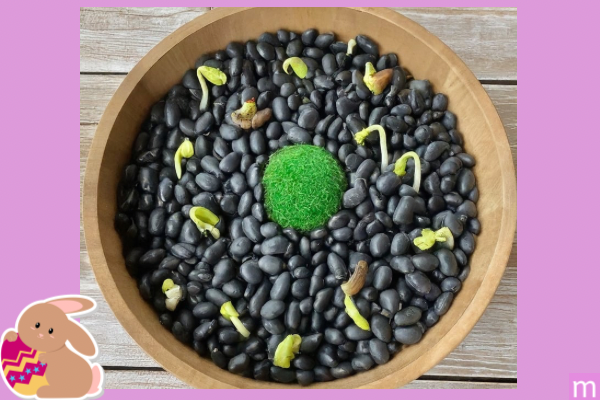
- Base: Fill the bin with dried black beans, green lentils, or chickpeas to represent garden soil.
- Sprouts: Add green pipe cleaners cut into short pieces to resemble grass sprouts.
- Eggs & Chicks: It’s fun to include plastic Easter eggs with halves painted yellow to look like cracked eggshells. Fill them with tiny chicks (pom poms or plastic chicks).
- Garden Tools: For pretend gardening fun, add miniature plastic rakes, shovels, or watering cans. You can also find these items at your local craft store or Walmart.
6. Bouncing Bunny Easter Fun
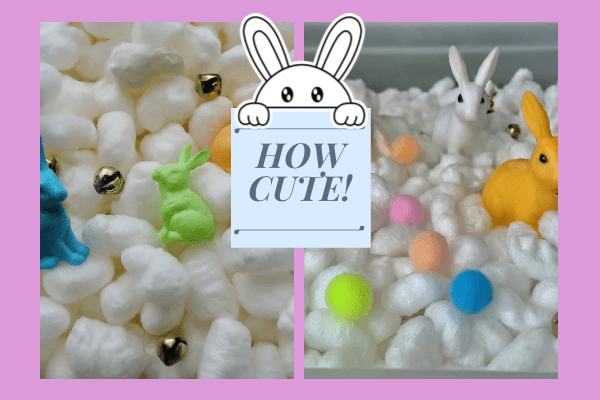
- Base: Fill the bin with white packing peanuts to create a cloud-like feel.
- Bunnies: Include plush or plastic bunnies in various sizes.
- Pom Poms: Add white and pastel-colored pom poms to represent fluffy bunny tails.
- Jingle Bells: Sneak in a few jingle bells for a surprising auditory element as the bin bounces around.
Watch the little bunnies tumble around in white-packing peanuts while hearing jingle bells hidden within the sensory bin.
Spring is arriving quickly; what are your plans?
With Spring right around the corner, I like to prepare ahead of time. It’s always fun to explore and create even more Spring sensory bins. The possibilities are endless!
Have you tried any sensory bins? If not, which one from this list is your favorite?
I thoroughly enjoy the black bean, considering its versatility. It can quickly become a garden for carrots, bean sprouts, rainbow rice tubs, and bird nests.
It is fun for all ages and helps younger children learn more about textures and different holidays.
So ditch the ordinary this Easter and dive into some creative Easter sensory bins! You can create hours of fun and learning for your little ones with some creativity.
These egg-cellent ideas are just a starting point—get creative and hatch some sensory fun!
Are you still looking for more Easter sensory bin ideas? I got you covered! The other day, I found this awesome pin on Pinterest called 21 Easy Spring Sensory Bins by Happy Toddler Playtime.
Enjoy!
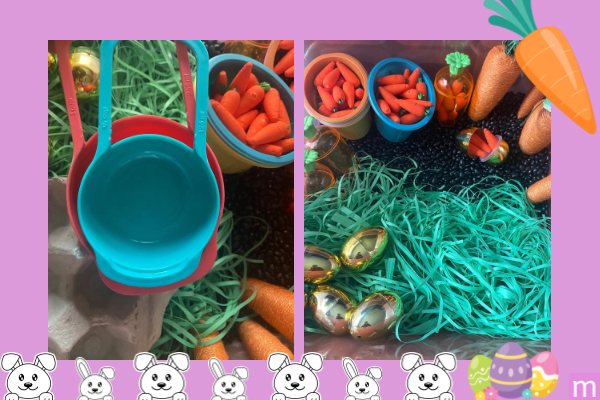
You can tap the icons above and below this page to contact me through Facebook, Twitter, LinkedIn, or Pinterest. If you need writing services, you can also use this form here.
Marlenny Linda is more than just a writer; she's a passionate bilingual advocate for families with children with medical conditions. With a background in teaching English (TESOL/TEFL) and a Bachelor of Science in Liberal Arts, she crafts engaging, SEO-optimized content that informs, inspires, and connects with these families.
Her specialty is long-form content, where she dives deep into the topics that matter most, from navigating educational resources to fostering a fulfilling life for your child. Marlenny's innovative approach keeps audiences engaged and coming back for more.


